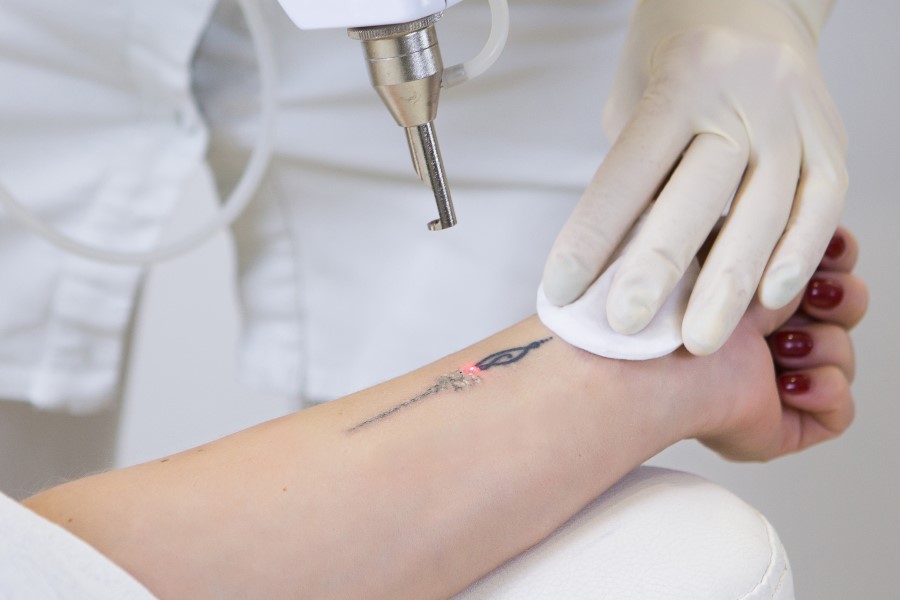The desire to have a tattoo is common in both young and old generations. However, this desire can be short-lived, with many individuals with tattoos regretting having them and looking for ways to erase them.
Fortunately, tattoo removal tools and methods have been invented. Among the most common and effective tattoo removal techniques is laser tattoo removal. This technique erases a tattoo after a few sessions and has minimal side effects. If you’re looking forward to removing your tattoo using this treatment, here’s what to expect before and after tattoo removal.
How Long Does Laser Tattoo Removal Take?

Averagely, a laser tattoo removal session lasts about 40 minutes. A patient might need three to six sessions to erase a tattoo. Nevertheless, the sessions you require to erase a tattoo depend on your tattoo size, age, and color. After every session, your skin will require healing before receiving another treatment.
How Does The Laser Tattoo Removal Work?
Once you get the tattoo, your body begins trying to get rid of the tattoo ink because your immune system perceives the ink as a foreign material. However, your body can’t eliminate the ink since it’s too large to be broken down by the white blood cells.
During the removal session, laser energy is directed to the ink to break it down into tiny pieces to help your immune system eliminate them through the lymphatic system. The more removal sessions you get, the more the ink is broken down and eliminated, making the tattoo fade away.
What Happens During The Removal?
During the removal session, expect:
- To be given protective eye shields
- The technician to examine your skin and test how it reacts to the laser. This step helps the technician choose the ideal energy for treatment.
- The technician to use the laser to pass intense light on the top of your skin, which will be absorbed by the tattoo color.
Small tattoos don’t require intense light to remove compared to larger ones. They also require fewer pulses. However, whether large or small, you’ll need several sessions to get rid of the tattoo. After each session, you’ll discover the tattoo is becoming lighter and the skin color is beginning to go back to normal.
Discomfort
Most people looking forward to having a laser tattoo removal wonder if the sessions are comfortable. Unfortunately, laser tattoo removal isn’t something you’ll enjoy having. Nevertheless, many patients don’t require anesthesia. However, depending on your tattoo’s location, you might need to apply topical anesthesia before the removal session.
What To Expect After A Laser Tattoo Removal Session

Immediately after the treatment, the tattoo area might appear whitish due to the release of carbon dioxide from the skin. Once you experience this sign, you shouldn’t be overwhelmed since it’s a normal part of healing. After an hour or so, the whiteness will begin to go away.
Then, the treated area will become red and sensitive. You might also experience swelling or blistering. These effects will improve with time and should subside within a week.
The first week after the treatment might be uncomfortable. Nevertheless, some patients resume their everyday lives immediately after the treatment.
Does Laser Tattoo Removal Affect The Area Surrounding The Tattoo?
A professional tattoo removal technician should be able to direct the wavelengths of energy to the tattoo without affecting the surrounding area. It’s, therefore, vital to research reputable tattoo parlors with trained personnel to remove a tattoo successfully. The advantages of getting your tattoo removed by a professional include successful tattoo removal and relatively more comfortable sessions.
Are There Side Effects Linked To Laser Tattoo Removal?
Laser tattoo removal is safer compared to other tattoo removal methods. This is because this treatment addresses the tattoo pigment only. Nevertheless, the treatment is associated with side effects that include:
- Risk of infection in the treated area
- Chances of sustaining a permanent scar
- Chances that the tattoo might not be erased completely (this depends on the color of the tattoo)
- Risk of developing hypopigmentation (paler skin color on the treated area)
- Developing hyperpigmentation (the treated skin becomes darker than the surrounding area)
Taking Care Of Yourself After The Treatment

Immediately after a laser tattoo removal session, patients are advised to avoid engaging in strenuous activities. Too much blood flow in the treated area can increase irritation and discomfort.
You should also prevent the treated area from getting soaked. So, you should restrain from swimming and taking soaking baths, especially during the first week of treatment.
Additionally, avoiding direct sunlight for at least 10 days after every treatment session is vital to prevent delayed healing and lower your chances of developing hyperpigmentation. If protecting the treated area from direct sunlight is impossible, always apply sun cream before stepping out.
Conclusion
With the above information, you now have an idea of what to expect during laser tattoo removal. This treatment doesn’t come with severe side effects. However, the success of the treatment depends on the facility and the technician. Therefore, before signing up for removal sessions, ensure the clinic is reputable and that the technicians are trained and experienced in laser tattoo removal.



